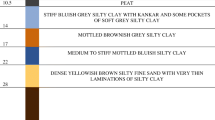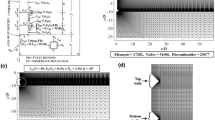Abstract
Creep behavior in soils is closely related to the stress level. In contrast, geotechnical engineering circular no. 7—soil nail walls (GEC#7) associate the creep behavior of soil nail systems with the presence of high-plasticity (PI) clays solely, regardless of the load level. Soil nail pullout tests are performed at the National Geotechnical Experimentation Site (NGES) of Texas A&M University to study the creep behavior of soil nails in high-PI clays. The data fits very well with a power-law model. The creep failure criterion from GEC#7 could be readily converted to the residual movement criterion in the model, which corresponds to the load level slightly higher than 80% of the ultimate load in this study. It verifies that the design practice by the Texas Department of Transportation (TxDOT) is working to control the long-term deformation by creep in high-PI clays by restricting the service load to one-third of the ultimate load. Besides, results from this research come with other recommendations to reduce long-term deformation by creep in high-PI clays during the lifetime of soil nails by applying the cycle and the preloading in the construction.











Similar content being viewed by others
References
Bi G (2015) A power law model for time dependent behavior of soils. Dissertation. Texas A&M University August, 2015
Bi G, Briaud J-L, Sanchez M et al (2019a) Power law model to predict creep movement and creep failure. J Geotech Geoenviron 145(9). https://doi.org/10.1061/(ASCE)GT.1943-5606.0002081
Bi G, Ni S, Wang D et al (2019b) Creep in primary consolidation with rate of loading approach. Sci Rep 9(8992). https://doi.org/10.1038/s41598-019-45498-0
Bi G, Li Z, Wang Q et al (2022a) An examination of creep failure criterion based on a strain threshold identified with a power law model. Mech Time-Dependent Mat 26:195–209. https://doi.org/10.1007/s11043-020-09483-9
Bi G, Ren C, Xu H et al (2022b) Creep failure of cohesive soils associated with different plasticity indexes. Environ Earth Sci 81(151). https://doi.org/10.1007/s12665-022-10271-6
Briaud J-L, Garland E (1985) Loading rate method for pile response in clay. J Geotech Eng 111(3):319–335. https://doi.org/10.1061/(ASCE)0733-9410(1985)111:3(319)
Briaud J-L, Griffin R, Yeung A et al (1998) Long-term behavior of ground anchors and tieback walls. Report No. FHWA/TX-99/1391-1. The Texas A&M University System, College Station, TX
Briaud J-L (2007) Spread footings in sand load settlement curve approach. J Geotech Geoenviron 133(8):905–920. https://doi.org/10.1061/(ASCE)1090-0241(2007)133:8(905)
Burmister DM (1949) The plasticity index classification system.
FHWA (2003) Geotechnical engineer circular no. 7: soil nail walls. Report No: FHWA0IF-03-17,. Department of Transportation
FHWA (2015) Geotechnical engineer circular no. 7: soil nail walls. Report No: FHWA-NHI-14-007,. Department of Transportation
Galvan M (2012) TxDOT Bridge Division, Proposal meeting RMC5 – 0-6784
Gassler G, Gudehus G (1981) Soil nailing some aspects of a new technique. In: Proceedings of the 10th international conference on soil mechanics and foundation engineering, 3(12):665-670. Sweden, Stockholm
Plumelle C, Schlosser F, Delage P et al (1990) French National Research Project on soil nailing: Clouterre. Design and Performance of Earth Retaining Structures. In: Lambe PC, Hansen LA (eds) Geotechnical Special Publication No. 25. ASCE, Reston, Virginia, pp 660–675
Qian T, Bi G, Yang S et al (2022) New interpretation of creep behavior of sand with load tests on spread footings. Arab J Geosci 15:1700. https://doi.org/10.1007/s12517-022-11011-7
Rabcewize L (1964a) The New Austrian Tunneling Method. Part 1, vol 16. Water Power, London, pp 453–457
Rabcewize L (1964b) The New Austrian Tunneling Method. Part 2, vol 16. Water Power, London, pp 511–515
Rabcewize L (1965) The New Austrian Tunneling Method. Part 3, vol 17. Water Power, London, pp 19–24
Rabejac S, Toudic P (1974) Constructions of a retaining wall between Versailles-Chantiers and Versailles-Matelots. Revue generale des chemins de fer 93:232–237
Schlosser F (1983) Similarities and differences in the behavior and design of retaining structures of reinforced earth and soil nailing. Annales de L’Institut Technique de Batiment et des Travaus Publics, No. 418, Paris, France
Sowers GF (1979) Introductory soil mechanics and foundations: geotechnical engineering, 4th edn. Macmillan, New York
Stocker M, Korber G, Gassler G et al (1979) Soil nailing, vol 2. International conference on soil reinforcement, Paris, France, pp 469–474
Conflict of interest
The authors declare no competing interests.
Funding
The authors appreciate the partial funding provided by the Fundamental Scientific Research in Universities of Jiangsu, China (22KJB410001), Texas Department of Transportation, and Natural Science Foundation of China (41877244, 41702315).
Author information
Authors and Affiliations
Corresponding author
Additional information
Responsible Editor: Zeynal Abiddin Erguler
Rights and permissions
Springer Nature or its licensor (e.g. a society or other partner) holds exclusive rights to this article under a publishing agreement with the author(s) or other rightsholder(s); author self-archiving of the accepted manuscript version of this article is solely governed by the terms of such publishing agreement and applicable law.
About this article
Cite this article
Bi, G., Liu, T., Wang, M. et al. Creep behavior of soil nails in the high-PI clay. Arab J Geosci 16, 310 (2023). https://doi.org/10.1007/s12517-023-11372-7
Received:
Accepted:
Published:
DOI: https://doi.org/10.1007/s12517-023-11372-7




